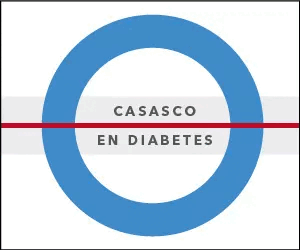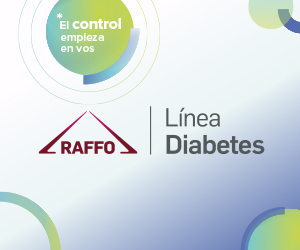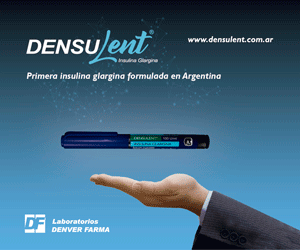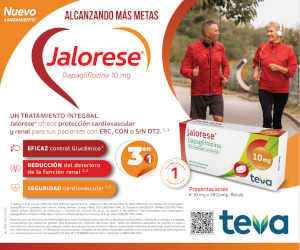Hypertension and diabetes in special situations and chronic complications: guidelines for clinical practice 2015. Committe on hypertension and other cardiovascular risk factors. Argentine Society of Diabetes
DOI:
https://doi.org/10.47196/diab.v50i1.73Keywords:
diabetes, hypertension, nephropathy, cardiovascular disease, elderlyAbstract
Introduction: arterial hypertension (AH) and diabetes mellitus (DM) are diseases of high prevalence which are frequently associated.
Objective: to provide useful information and relevant knowledge to support clinical practices that aim at optimizing the diagnosis and offering appropriate therapeutic decisions.
Methodology: these Guidelines for Clinical Practice were created based on the evidence available, large clinical trials published in the last years and adapted diagnostic and therapeutic
resources in our country, The outcomes of our effort resulted in a set of recommendations, focusing on special situations such as pregnancy, childhood, the elderly, and chronic complications.
Conclusions: AH increases the progression and development of chronic micro and macro vascular complications related to DM. The impact of Hypertension treatment is highly significant in reducing morbidity and mortality in people with diabetes, and in the onset and progression of micro and macrovascular complications. In most adults with DM and HA the goal it is to achieve BP
<140/90 mmHg. In more vulnerable elderly, targets are less tight. In people with kidney transplantation, ACR (albumin/creatinine ratio) >300 mg /g, young adults, objectives may be lower (<130-80 mmHg) if achieved without adverse events related to treatment. Avoid DBP <60 mmHg in people over 60 years.
The choice of treatment will depend on age, intolerance or any contraindication and according to the therapeutic target of each chronic complication. The treatment should be early and therapeutic goals should be individualized according to the age, comorbidities and target organ damage.
References
OMS 2013. A global brief on hypertension. Hypertension: the basic facts. Disponible en:http://apps.who.int/iris/bitstream/10665/79059/1/WHO_DCO_WHD_2013.2_eng.pdf
ENFR 2005. Disponible en: http://www.msal.gov.ar/ent/images/stories/vigilancia /pdf/ encuesta_ factores_riesgo_2005_completa.pdf.
ENFR 2009. Disponible en: http://www.msal.gov.ar/ent/images/stories/vigilancia /pdf/segunda_ encuesta_nacional_de_factores_de_riesgo_2011.pdf.
ENFR 2013. Disponible en: http://www.msal.gov.ar/images/stories/bes/graficos/ 0000000544cnt-2014-09_3er-encuesta-nacional-factores-riesgo.pdf.
Committee for Practice Guidelines (CPG) of the European Society of Cardiology (ESC) Recommendation for Guidelines production. A document for Task Force Members Responsible for the Production and Updating of ESC Guidelines: Disponible en:http://www.escardio.org/static_file/Escardio/Guidelines/ESC%20Guidelines%20for%20Guidelines%20Update%202010.pdf.
The Forth Report on the Diagnosis, Evaluation, and Treatment of High Blood Pressure in Children and Adolescents. Task Force. Pediatrics 2004; 114:555-576.
Consenso sobre factores de riesgo de enfermedad cardiovascular en pediatría. Hipertensión arterial en el niño y el adolescente. Arch. Argent. Pediatr 2005; 103(4):348-366.
Donaghue K, Wadna R, Dimaglio L, et ál. Micro and macrovascular complications in children and adolescents. Ispad Clinical Practice Consensus Guidelines. Pediatric Diabetes 2014; 15(20):257-26.
Canadian Diabetes Assocition Clinical Practice Guidelines Expert Committee. Type 1 Diabetes in children and adolescents. Can J. Diabetes 2013; 37:S153-S162.
Canadian Diabetes Association Clinical Practice Guidelines Expert Committee. Type 2 diabetes in children and adolescents. Can J. Diabetes 2013, 37:S163-S167.
Rodríguez B, Mayer Davis E, et ál. Prevalence of cardiovascular disease risk factors in U.S. Children and adolescents with diabetes. Diabetes Care 2009; 29(8):1891-1896
Group Today Study. Rapid rise in hypertension and nephropathy in youth with type 2 diabetes. The Today Clinical Trial. Diabetes Care 2013; 36:1735-1741.
American Diabetes Association. Standards of Medical Care in Diabetes-2015. Diabetes Care 2015; 38 (S1):1-90.
Di Marco I, Basualdo MN, Paladino S, et ál. GPC estados hipertensivos del embarazo. 2010. Disponible : www.sarda.org.ar/Profesionales/Publicaciones/Revista_Sarda/2011/Guia_de_practica_clinica_estados_hipertensivos_del_embarazo_2010.
SOGC. Clinical Practice Guideline Nº 206: Diagnosis, evaluation, and management of hypertensive disorders of pregnancy. Society of Obstetricians and Gynaecologists of Canada. JOGC S1S48, 2008.
Majul C, Bendersky M, Diaz M, y col. Consenso de Hipertensión Arterial. Consejo Argentino de Hipertensión Arterial “Dr. Eduardo Braun Menéndez”. Rev. Arg. Cardiol 2013; 81(Suppl 2):1-72.
The management of severe pre-eclampsia/eclampsia. Royal College of Obstetricians and Gynaecologists. 2012.
WHO. WHO recommendation for prevention and treatment of preeclampsia-eclampsia. 2011.
Guía para el diagnóstico y tratamiento de la hipertensión en el embarazo. 2010. Disponible en: www.msal.gov.ar.
International Diabetes Federation. Managing older people with type 2 diabetes. Global Guideline. Disponible en: http://www.idf.org/sites/default/files/IDF-Guideline-for-older-people-T2D.pdf.
Franklin SS, Gustin W. Hemodynamic patterns of age-related changes in blood pressure. The Framingham Heart Study. Circulation 1999; 96:308-315.
Muller M. Treatment of hypertension in the oldest old: a critical role for frailty. Hypertension 2014; 63:433-441.
Welton, PK. Primary prevention of hypertension: clinical and public health advisory from The National High Blood Pressure Education Program. JAMA 2002; 288:1882-1888
Zekry D, Frangos E, Graf C, Michel JP, et ál. Diabetes, comorbidities and increases long term mortality in older patients admitted for geriatric inpatient care. Diabetes Metabolism 2012; 38(2)149-55.
Moser M, Setaro JF. Resistant or difficult to control hypertension. New Engl. J. Med. 2006; 355:385-392.
Clinical Practice Guidelines for the management of hypertension in the community: a statement by the American Society of Hypertension and the International Society of Hypertension. J of Hypertension 2014; 32:33-15.
Mancia G, Fagard R, Narkiewicz K, et ál. ESH/ESC Guidelines for tle management of arterial hypertension: the Task Force for the Management of Arterial Hypertension of the European Society of Hypertension (ESH) and the European Society the Cardiology (ESC). Eur. Heart J. 2013; 34:2159-2259.
Rosendorff C, Lackkland D, Aronow W, et ál. Treatment of hypertension in patientes with coronary artery disease. A scientific statement from the American Heart Association, America College of Cardiology and America Society of Hypertension. Disponible en: http://hyper.ahajournals.org/by guest on April 22, 2015.
Patel A, ADVANCE Collaborative Group, MacMahon S, Chalmers J, Neal B, Woodward M, et ál. Effects of a fixed combination of perindropil and indapamide on macrovascular and microvascular outcomes in patients with type 2 diabetes mellitus (the ADVANCE trial). Lancet 2007; 370: 829-840.
ACCORD Study group. Effects of intensive blood-pressure control in type 2 diabetes mellitus. N. Engl. J. Med. 2010; 362:1575-1585.
Curb D, Sara L, Pressel Jeffrey A. Effect of diuretic based antihypertensive treatment on cardiovascular disease in older diabetic patients with isolated systolic hypertension. JAMA 1996; 276(23):1886-1892.
www.san.org.ar/docs/INFORME-PRELIMINAR-REGISTRO-2009-2010_ VERSION-ESPANOL.pdf. Último acceso: 10 de noviembre de 2014.
National Kidney Foundation. KDOQI clinical practice guidelines and clinical practice recommendations for diabetes and chronic kidney disease. Am. J. Kidney Dis. 2007; 49 (Suppl 2):S12-S154.
Kidney Disease: Improving Global Outcomes (KDIGO) CKD Work Group. KDIGO 2012 Clinical. Practice Guideline for the Evaluation and Management of Chronic Kidney Disease. Kidney Int. Suppl. 2013; 3:1-150.
James PA, Oparil S, Carter BL, et ál. 2014 Evidence-based guideline for the management of high blood pressure in adults: report from the panel members appointed to the Eighth Joint National Committee (JNC 8). JAMA 2014; 311(5):507-520.
Tuttle KR, Bakris GL, Bilous RW, et ál. Diabetic kidney disease: a report from an ADA Consensus Conference. Am. J. Kidney Dis. 2014;64:510-33 y Diabetes Care 2014; 37:2864-2883.
Aronow WS, Fleg JL, Pepine CJ, et ál. ACCF/AHA 2011 expert consensus document on hypertension in the elderly: a report of the American College of Cardiology Foundation Task Force on Clinical Expert Consensus Documents developed in collaboration with the American Academy of Neurology, American Geriatrics Society, American Society for Preventive Cardiology, American Society of Hypertension, American Society of Nephrology, Association of Black Cardiologists, and European Society of Hypertension. J. Am. Soc. Hypertens. 2011; 5:259-352.
De Galan B, Perkovic V, Ninomiya T. Lowering blood pressure reduces renal events in type 2 diabetes. J. Am. Soc. Nephrol. 2009; 20:883-892.
Chobanian AV, Bakris GL, Black HR, et ál. Seventh report of the Joint National Committee on Prevention, Detection, Evaluation, and Treatment of High Blood Pressure. Hypertension. 2003;42:1206-1252.
Van Buren PN, Toto R. Hypertension in diabetic nephropathy: epidemiology, mechanisms, and management. Adv. Chronic Kidney Dis. 2011;18:28-41.
Lewis EJ, Hunsicker LG, Clarke WR, et ál. Renoprotective effect of the angiotensin-receptor antagonist irbesartan in patients with nephropathy due to type 2 diabetes. N. Engl. J. Med. 2001; 345:851-860.
Parving HH, Brenner BM, McMurray JJ, et ál. ALTITUDE Investigators. Cardiorenal end points in a trial of aliskiren for type 2 diabetes. N. Engl. J. Med. 2012; 367:2204-13.
Imai E, Chan JC, Ito S, et ál. ORIENT study investigators. Effects of olmesartan on renal and cardiovascular outcomes in type 2 diabetes with overt nephropathy: a multicentre, randomised, placebo-controlled study. Diabetologia. 2011; 54: 2978-2986.
Fried LF, Emanuele N, Zhang JH, et ál. VA NEPHRON-D Investigators. Combined angiotensin inhibition for the treatment of diabetic nephropathy. N. Engl. J. Med. 2013; 369:1892-90
National Institute for Health and Clinical Excellence. Hypertension: clinical management of primary hypertension in adults. CG127. 2011. http://guidance.nice.org.uk/CG127/ Guidance/pdf/English. Último acceso: 16 de noviembre de 2014.
Wassermann A. ¿Hay que abandonar la hidroclorotiazida como diurético de elección en la hipertensión arterial? Revista de la Sociedad Argentina de Cardiología. 2011; 77:152-5.
Bakris GL. Recognition, pathogenesis, and treatment of different stages of nephropathy in patients with type 2 diabetes mellitus. Mayo Clin. Proc. 2011; 86:444-456.
Stern A, Sachdeva S, Kapoor R, et ál. High blood pressure in dialysis patients: cause, pathophysiology, influence on morbidity, mortality and management. J. Clin. Diagn. Res. 2014 Jun; 8(6):ME01-4.
Gutiérrez-Adrianzén OA, Moraes MEA, Almeida AP, et ál. Pathophysiological, cardiovascular and neuroendocrine changes in hypertensive patients during the hemodialysis session Journal of Human Hypertension. 23 October 2014 ldoi:10.1038/jhh.2014.93
Robinson BM, Tong L, Zhang J, Wolfe RA, Goodkin DA, Greenwood RN, Kerr PG, Morgenstern H, et ál. Blood pressure levels and mortality risk among hemodialysis patients in the Dialysis Outcomes and Practice Patterns Study. Kidney Int. 2012; 82(5):570-80
KDIGO Clinical Practice Guideline for the Management of Blood Pressure in Chronic Kidney Disease. Blood pressure management in kidney transplant recipients (CKD T). Kidney International Supplements 2012; 2:370-371.
Cheung N, Mitchell P, Wong TY. Diabetic retinopathy. Lancet 2010; 376 (9735): 124-136.
Kempen JH, O'Colmain BJ, Leske MC, et ál. The prevalence of diabetic retinopathy among adults in the United States. Archives of Ophthalmology 2004; 122 (4): 552-563.
UK Prospective Diabetes Study Group (UKPDS). Tight blood pressure control and risk of macrovascular and microvascular complications in type diabetes. BMJ 1998; 317:703-13.
Gallego PH, Craig ME, Hing S, Donaghue KC. Role of blood pressure in development of early retinopathy in adolescents with type 1 diabetes: prospective cohort study. BMJ 2008; 337: a918.
Beulens JW, Patel A, Vingerling JR, et ál. Effects of blood pressure lowering and intensive glucose control on the incidence and progression of retinopathy in patients with type 2 diabetes mellitus: a randomised controlled trial. Diabetologia 2009; 52 (10): 2027-2036.
Chaturvedi N, Sjolie AK, Stephenson JM, et ál. Effect of lisinopril on progression of retinopathy in normotensive people with type 1 diabetes. The EUCLID Study Group. EURODIAB Controlled trial of lisinopril in insulin-dependent diabetes mellitus. Lancet. 1998; 351 (9095): 28-31.
Sjolie AK, Klein R, Porta M, et ál. Effect of candesartan on progression and regression of retinopathy in type 2 diabetes (DIRECT-Protect 2): a randomised placebo-controlled trial. Lancet 2008; 372 (9647): 1385-93.
Chaturvedi N, Porta M, Klein R, et ál. Effect of candesartan on prevention (DIRECT -Prevent 1) and progression (DIRECT-Protect 1) of retinopathy in type 1 diabetes: randomised, placebo-controlled trials. Lancet 2008; 372 (9647): 1394-1402.
Mauer M, Zinman B, Gardiner R, et ál. Renal and retinal effects of enalapril and losartan in type 1 diabetes. N. Engl. J. Med. 2009; 361 (1): 40-51.
Klein R, Moss SE, Sinaiko AR, et ál. The relation of ambulatory blood pressure and pulse rate to retinopathy in type 1 diabetes mellitus: the renin-angiotensin system study. Ophthalmology 2006; 113 (12): 2231-2236.
Group AS, Cushman WC, Evans GW, et ál. Effects of intensive blood pressure control in type 2 diabetes mellitus. N. Engl. J. Med. 2010; 362 (17): 1575- 1585.
Saravia M. Persistent diffuse diabetic macular edema. The role of the internal limiting membrane as a selective membrane: the oncotic theory. Med Hypotheses 2011; 76 (6): 858-860.
Chew EY, AmbrosiusnWT, Davis MD, et ál. Effects of medical therapies on retinopathy progression in type 2 diabetes . N. Engl. J. Med. 2010; 363: 233-244.
Fong DS, Aiello L, Gardner TW. Diabetic retinopathy. Diabetes Care 2003; 26: 226-229.
Mohamed Q, Gillies MC, Wong TY. Management of diabetic retinopathy: a systematic review. JAMA 2007; 298 (8): 902-916.
Brown DM, Nguyen QD, Marcus D, et ál. Long-term outcomes of ranibizumab therapy for diabetic macular edema: the 36-month results from two phase III trials RISE and RIDE. Ophthalmology 2013; 120 (10): 2013-2022.
Massin P, Bandello F, Gandner TW, et ál. Safety and efficacy of ranibizumabin diabetic macular edema. RESOLVE study. A 12 month randomized, controlled, double masked, multicenter phase II study. Diabetes Care 2010; 33: 2399-2405.
Assman G, Cullen P, Schulte H. Simple scoring scheme for calculating the risk of acute coronary events based on the 10-year follow-up of the Prospective Cardiovascular Munster (PROCAM) study. Circulation 2002; 105: 310-315.
Hansson L, Zanchetti A, Carruthers SG, et ál. Effects of intensive blood-pressure lowering and low-dose aspirin in patients with hypertension: principal results of the Hypertension Optimal Treatment (HOT) randomised trial. HOT Study Group. Lancet 1998; 351(9118):1755-1762.
Grupo de Trabajo de Diabetes. Prediabetes y enfermedades cardiovasculares de la Sociedad Europea de Cardiología (ESC) y la European Association for the Study of Diabetes (EASD). Guía de práctica clínica de la ESC sobre diabetes. Prediabetes y enfermedad cardiovascular, en colaboración con la European Association for the Study of Diabetes. Rev. Esp. Cardiol. 2014; 67(2): 136. e1-e56.
James PA, Oparil S, Carter BL, et ál. 2014 Evidence-based guideline for the management of high blood pressure in adults: report from the panel membersappointed to the Eighth Joint National Committee (JNC 8). JAMA 2014; 311(5):507-520.
Bangalore S, Kumar S, Lobach I, et ál. Blood pressure targets in subjects with type 2 diabetes mellitus/impaired fasting glucose: observation from traditional and Bayesian random-effects meta-analysis of randomized trials. Circulation 2011; 123:2799-2810.
McBrien K, Rabi DM, Campbell N, et ál. Intensive and standard blood pressure targets in patients with type 2 diabetes mellitus. Systematic review and meta-analysis. Arch. Intern. Med. 2012; 172: 1296-1303.
Messerli FH, Mancia G, Conti CR, et ál. Dogma disputed: can aggressively lowering blood pressure in hypertensive patients with coronary artery disease be dangerous? Ann. Intern. Med. 2006; 144(12):884-893.
Cooper-DeHoff RM, Gong Y, Handberg EM, et ál. Tight blood pressure control and cardiovascular outcomes among hypertensive patients with diabetes and coronary artery disease. JAMA 2010; 304(1): 61-68.
Bangalore S, Qin J, Sloan S, et ál. What is the optimal blood pressure in patients after acute coronary syndromes? Relationship of blood pressure and cardiovascular event in the PRavastatin Or atorVastatin Evaluation and Infection Therapy-Trombolysis in Myocardial Infarction (PROVE-IT TIMI) 22 trial. Circulation 2010, 122: 2142-215.
Steg PG, James SK, Atar D, et ál. ESC Guidelines for the management of acute myocardial infarction in patients presenting with STsegment elevation. Eur. Heart J. 2012; 33:2569-2619.
Fox K, Garcia MA, Ardissino D, et ál. Guidelines on the management of stable angina pectoris: executive summary. The task force on the management of stable angina pectoris of the European Society of Cardiology. Eur. Heart J. 2006;27:1341-1381.
Fonseca VA. Effects of beta-blockers on glucose and lipid metabolism. Curr. Med. Res. Opin. 2010; 26:615-629.
Malcolm A. Peripherical vascular disease and reconstruction. In: The foot in diabetes. Fourth Edition, edited by AJM Boulton, Cavanagh P, Rayman G. John Wiley & Sons, Ltd. England, p.251-273, 2008.
Boulton AJM, Vileikyte L, Ragnarson-Tennvall, Apelqvist J. The global burden of diabetic foot disease. Lancet 2005; 366, 1721-1725.
Reboldi G, Gentile G, Angeli F, et ál. Effects of intensive blood pressure reduction on myocardial infarction and stroke in diabetes: a meta-analysis in 73,913 patients. J Hypertens 2011; 29:1253-1169.
Shahin Y,Mazri F, ChetterI. Do angiotensine converting enzyme inhibitors improbe walking distance in patients with symptomatic lower limb arterial disease? Int. J. Surg. 2011; 9: 209-213.
Yusuf S, Teo KK, Pogue J, et ál. The ONTARGET Investigators telmisartan ramipril or both in patients at high risk for vascular events: N. Engl. J. Med. 2008; 358: 1547-59.
Guía de práctica de ESC sobre diagnóstico y tratamiento de las enfermedades periféricas. Grupo de trabajo de diagnóstico y tratamiento de las enfermedades arteriales periféricas. Sociedad Europea de Cardiología ESC. Rev. Esp. Cardiol. 2012: 65 (2); 172 e1-e57.
Weber MA, Bakris CL, Amerson K, et ál. Cardiovascular events during differening therapies in patients with diabetes. J. AM. Coll. Cardiol. 2010; 56: 77-85.
Lawes CMM, Bennett DA, Feigin VL, et ál. Blood pressure and stroke: an overview of published reviews. Stroke 2004; 35: 776-785.
Zanchetti A, Grassi G, Mancia G. When should antihypertensive drug treatment be initiated and to what levels should systolic blood pressure be lowered? A critical reappraisal. J. Hypertens. 2009; 27:923-934.
Mancia G, Laurent S, Agabiti-Rosei E, et ál. Re-appraisal of European guidelines on hypertension management. A European Society of Hypertension Task Force document. J. Hypertens. 2009; 27:2121-2158.
Law MR, Morris JK, Wald NJ. Use of blood pressure lowering drugs in the prevention of cardiovascular disease: meta-analysis of 147 randomised trials in the context of expectations from prospective epidemiological studies. BMJ 2009; 338:b1665.
Turnbull F, Neal B, Ninomiya T, et ál. Blood pressure lowering treatment trialists’ collaboration. Effects of different blood pressure-lowering regimens on major cardiovascular events in individuals with and without diabetes mellitus: results of prospectively designed overviews of randomized trials. Arch. Intern. Med. 2005; 165:1410-1419.
Sandset EC, Bath PM, Boysen G, et ál. The angiotensin-receptor blocker candesartan fortreatment of acute stroke (SCAST): a randomised, placebo-controlled, double-blind trial. Lancet 2011; 377:741-750.
Fuentes Patarroyo SX, Anderson C. Blood pressure lowering in acute phase of stroke, latest evidence and clinical implication. Ther Adv. Chronic. Dis. 2012; 3:163-171.
Arima H, Chalmers J, Woodward M, et ál. Lower target blood pressures are safe and effective for the prevention of recurrent stroke: the PROGRESS trial. J. Hypertens 2006; 24:1201-1208.
PROGRESS Collaborative Group. Randomised trial of a perindoprilbased blood-pressure-lowering regimen among 6105 individuals with previous stroke or transient ischaemic attack. Lancet 2001; 358:1033-1041.
Kario K, Pickering TG, Matsuo T, et ál. Stroke prognosis and abnormal nocturnal blood pressure falls in older hypertensive. Hypertension 2001; 38: 852-857.
Kario K, Pickering TG, Umeda Y, et ál. Morning surge in blood pressure as a predictor of silent and clinical cerebrovascular disease in elderly hypertensives: a prospective study. Circulation 2003; 107:1401-1406.
Downloads
Published
How to Cite
Issue
Section
License

This work is licensed under a Creative Commons Attribution-NonCommercial-NoDerivatives 4.0 International License.
Dirección Nacional de Derecho de Autor, Exp. N° 5.333.129. Instituto Nacional de la Propiedad Industrial, Marca «Revista de la Sociedad Argentina de Diabetes - Asociación Civil» N° de concesión 2.605.405 y N° de disposición 1.404/13.
La Revista de la SAD está licenciada bajo Licencia Creative Commons Atribución – No Comercial – Sin Obra Derivada 4.0 Internacional.
Por otra parte, la Revista SAD permite que los autores mantengan los derechos de autor sin restricciones.

































